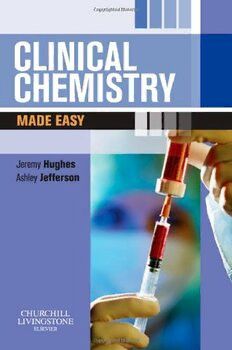
Clinical chemistry made easy PDF
Preview Clinical chemistry made easy
CLINICAL CHEMISTRY MADE EASY ForElsevier: Commissioning Editor: TimothyHorne DevelopmentEditor: Ailsa Laing ProjectManager: EmmaRiley Designer:Charles Gray Illustration Manager:MerlynHarvey Illustrator: MarionTasker CLINICAL CHEMISTRY MADE EASY Jeremy Hughes MAFRCPEPhD Wellcome TrustSeniorResearchFellowinClinical Scienceand HonoraryConsultant PhysicianattheRoyalInfirmary Edinburgh, MRC CentreforInflammationResearch,The Queen’sMedical ResearchInstitute, Edinburgh, UK Ashley Jefferson MDMRCP Clinical AssociateProfessor,Division ofNephrology,University of Washington,Seattle,USA Foreword by John Iredale DMFRCPFMedSci Professor ofMedicine, UniversityofEdinburgh Edinburgh London NewYork Oxford Philadelphia StLouis Sydney Toronto 2008 CHURCHILLLIVINGSTONE AnimprintofElsevierLimited #2008,ElsevierLimited.Allrightsreserved. Nopartofthispublicationmaybereproduced,storedinaretrievalsystem,ortransmitted inanyformorbyanymeans,electronic,mechanical,photocopying,recordingor otherwise,withoutthepriorpermissionofthePublishers.Permissionsmaybesought directlyfromElsevier’sHealthSciencesRightsDepartment,1600JohnF.Kennedy Boulevard,Suite1800,Philadelphia,PA19103-2899,USA:phone:(þ1)2152393804;fax: (þ1)2152393805;or,e-mail:[email protected] requeston-lineviatheElsevierhomepage(http://www.elsevier.com),byselecting ‘Supportandcontact’andthen‘CopyrightandPermission’. Firstpublished2008 ISBN:978-0-443-07197-3 InternationaleditionISBN:978-0-443-07196-6 BritishLibraryCataloguinginPublicationData AcataloguerecordforthisbookisavailablefromtheBritishLibrary LibraryofCongressCataloginginPublicationData AcatalogrecordforthisbookisavailablefromtheLibraryofCongress Notice Knowledgeandbestpracticeinthisfieldareconstantlychanging.Asnewresearchand experiencebroadenourknowledge,changesinpractice,treatmentanddrugtherapymay becomenecessaryorappropriate.Readersareadvisedtocheckthemostcurrent informationprovided(i)onproceduresfeaturedor(ii)bythemanufacturerofeach producttobeadministered,toverifytherecommendeddoseorformula,themethodand durationofadministration,andcontraindications.Itistheresponsibilityofthe practitioner,relyingontheirownexperienceandknowledgeofthepatient,tomake diagnoses,todeterminedosagesandthebesttreatmentforeachindividualpatient,andto takeallappropriatesafetyprecautions.Tothefullestextentofthelaw,neitherthe PublishernortheAuthorsassumeanyliabilityforanyinjuryand/ordamagetopersons orpropertyarisingoutorrelatedtoanyuseofthematerialcontainedinthisbook. ThePublisher The publisher's policy is to use paper manufactured from sustainable forests PrintedinChina This page intentionally left blank This page intentionally left blank Foreword Thefunctionsofcellsaregovernedbythelawsofchemistryandphys- ics, and biochemical reactions underlie the fundamental processes of life. For these reasons, it is no surprise that in many countries a high school chemistry qualification is a prerequisite for undergraduate admission to medical school. Medical students become exposed to biochemistry during their early training and many joke about the impenetrability of the subject. Indeed one classmate of mine, a witty songwriter, penned the classic ‘Don’t cry for me biochemistry, the truth is I never learnt you’, to be sung to the tune of ‘Don’t cry for me Argentina’, from the then hit Lloyd Webber musical ‘Evita’. Of course,thislevitydisguisesthefactthatmedicalgraduatesinvariably acquireagoodworkingknowledge ofbiochemicalprocess. Having acquired a grounding in biochemistry, as clinical students andjuniordoctorswearethenconfrontedwiththechallengeofassim- ilatingthatknowledgewiththepracticeofmedicineandexploitingit in clinical practice. Nowhereis that assimilation more direct than the fieldofclinical chemistry.However,the expandingcontentofunder- graduate syllabuses means that the time and opportunity to make this synthesis is becoming eroded. Moreover, the integration of pre- clinical biochemistry with the approach to clinical problems is not always straightforward. For example, understanding the Henderson– Hasselbalch equation and the principles underlying pH balance and bufferingmayseemstraightforwardinabstract,butgroupingthepat- terns of changes in pH and accompanying alterations in the PO and 2 PCO inthe bloodgasesofabreathless patientcanseem dauntingto 2 themedicalstudentandjuniordoctor.Theapproachtoclinicalchem- istryinrealclinicalsituationsrequiresknowledge,experienceandan integratedandclinicallyrelevantmodel.Itispreciselythisintegrated model which Jeremy Hughes and Ashley Jefferson have brought together inthistext. The use of appropriate clinical context throughout the book illus- trates how clinical chemistry tests can be deployed to rapidly obtain information critical for the management of sick patients.This area of medicineisnowofessentialimportancegiventhechangesinthepro- cess of care delivery in hospitals. Junior doctors are frequently called to see sick patients with whom they are unfamiliar, and for whom a rapid appraisal of clinical need and diagnosis will be required. The Foreword armamentariumofclinicalchemistrytestsisinvaluableinthissetting – frequently simple investigations, such as blood gas measurements, can rapidly provide information essential to diagnosis and manage- ment.Farfrombeingasettingneglectedbytheauthors,clearandcon- cise guidance to the use and interpretation of tests in the emergency setting is a particular strength of this volume. An additional area of focusistheroleofdrugsininfluencingtheresultsofclinicalchemistry tests and as possible causes of abnormalities in routine tests under- takeninboththecommunityandhospitalsettings.Withtheincreasing numberofelderlypatientswhoarealltoofrequentlyexposedtopoly- pharmacy,thisareaalsowillassumeagreaterandgreaterimportance inthediagnosisandeffectivemanagementofourpatientpopulation. Thisconciseandhighlyreadabletextprovidesexactlytheinforma- tion that senior clinical students and junior doctors need to request, arrange and interpret clinical chemistry tests effectively, and in so doing enhance clinical care. It is the kind of book I wish had been available when I was a student and should be valuable to trainees across all specialities. There is no longer any excuse for biochemistry and clinical chemistry to be a neglected or ‘tearful’ partner in the curriculum. JohnIredale Edinburgh2007 viii Preface Clinicians are unable to provide adequate medical care in isolation. Theyaredependentuponnumerouslaboratorydisciplinestoassistin the management of patients with varied medical problems. Depart- ments of Clinical Chemistry and related departments such as Micro- biologyandClinicalImmunologyplayaveryimportantroleinpatient care.Theyprovidecriticallyimportantinformationthatmaybeeither diagnostic,asinthelevelsofcardiacenzymes,orfacilitatetheaccurate monitoringofconditionssuchassystemicinflammationorhepaticfail- ure.Althoughmanyofthesetestsmaybeinterpretedinisolation,itis usuallyimportanttoexamineany‘trends’thatareevident,e.g.deterio- rationinrenalfunction,overallcontrolofdiabetesmellitus. Itisimperative to realisethattheuseofsimple clinical acumenand skillisacriticallyimportantfacetofpatientcare.Itisalwaysinadequate toinvestigateapatientbysimply‘orderingafewtests’.Althoughthere is unquestionably a role for routine screening tests in certain patient populations,itisusefultorequestandinterpretpertinentinvestigations in the clinical context of the individual patient. Indeed, significant errors in clinical management may ensue if data derived from labora- toryinvestigationsareacteduponwithoutanadequateclinicalassess- mentofthepatient. Junior clinical staff are typically the first point of contact for ward staff who are concerned about the condition of inpatients during the night or at the weekend. Often, junior doctors will be required to assess and treat patients ‘out of hours’, despite the fact that they may not be directly involved in their routine medical care. The key tosuccessinthesecircumstancesis: 1. Gettogripswiththeacuteproblem,pertinentmedicalbackground andcurrentdrugtreatment. 2. Examinethepatientbrieflywithparticularemphasisupontherel- evantphysiological system. 3. If the diagnosis is not apparent then make a differential diagnosis andinstituteteststhatwillenableyoutomakeadefinitivediagno- sis.Thismayincludeclinicalchemistry,haematological,radiologi- calandcardiological investigations. 4. Reconsider the clinical situation when the results ofinvestigations becomeavailableandintegratealloftheavailabledata.Itmaywell benecessarytoinstitute appropriatetherapyatthis point.
